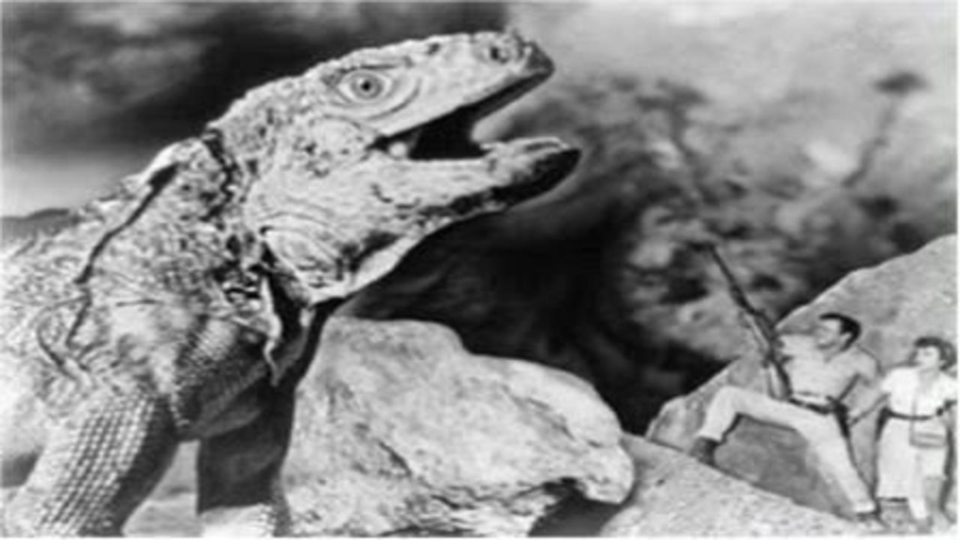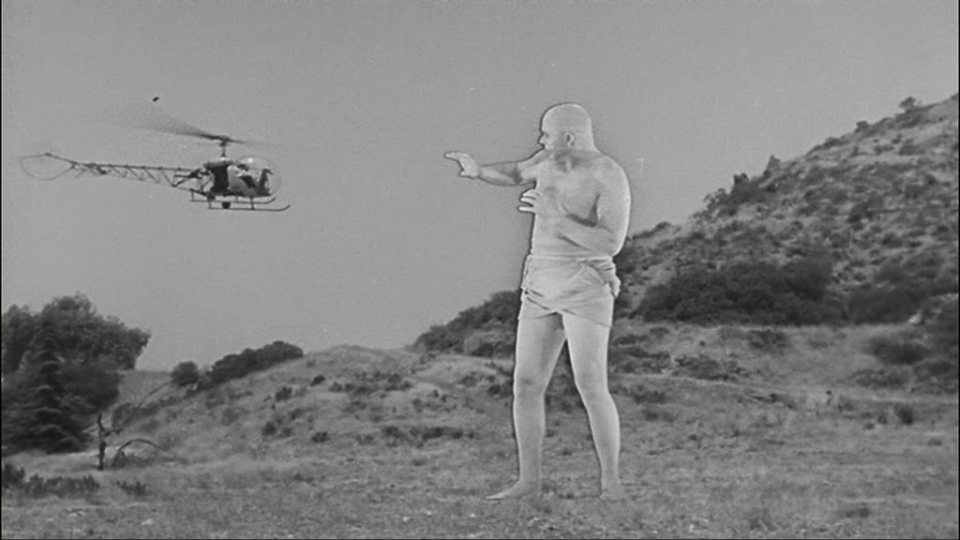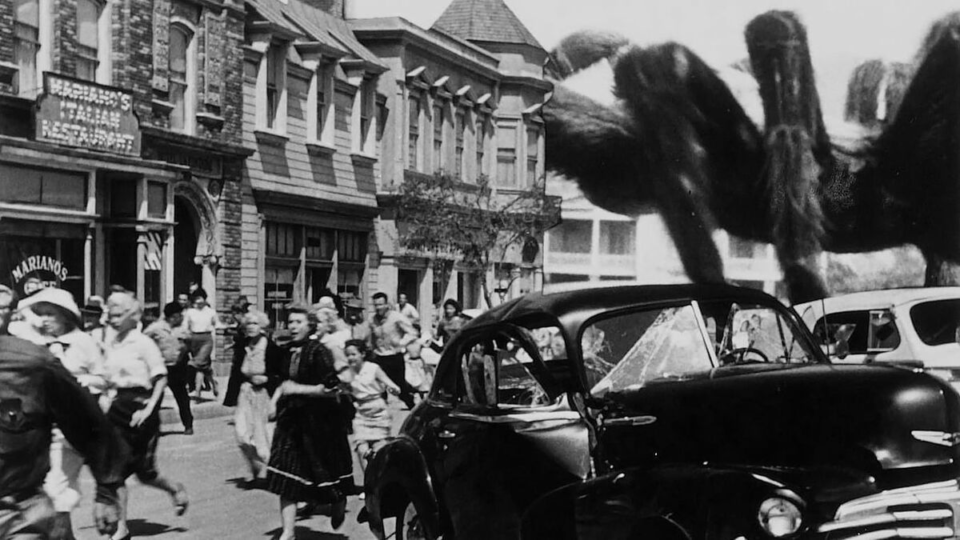An American Monster King: Remembering Bert I. Gordon

His initials spelled “BIG” and that’s what Bert I. Gordon did. From big spiders and big ants to big locusts and big people, Gordon put them all on the screen in a series of entertaining creature features—most of them made during the 1950s at the height of the giant monster cycle.
On March 8, 2023, Gordon passed away at the age of 100, leaving behind a monstrous movie legacy. It’s arguable he was the closest the 1950s had to an American monster movie auteur. Roger Corman or Jack Arnold may also come to mind, both having helmed their fair share of monster pictures. But while Corman’s filmography darted between genres and styles, and Arnold was a contract director at Universal, Gordon often produced, wrote, directed, and crafted the special effects for a fairly consistent body of giant monster movies—a veritable canon unto itself.
But like many such directors, Gordon was not always an easy person to work with. Several actors have recalled his irritability and infuriating comments on set. It’s perhaps reflected in how imperfect his films are. Many of them are uneven and rough around the edges, but they nonetheless remain significant genre landmarks, touching everything from The Simpsons to Joe Dante’s Matinee. To that end, the films mirror their director: often flawed but leaving an indelible mark.
The following is a selection of four Bert I. Gordon pictures, chosen because they reflect both his development as a filmmaker and the sub-genre he was most known for: the giant monster movie. If you’re learning about Gordon for the first time, I hope this encourages you to seek his films out. And for the lifelong fan, I hope you’ll consider a timely rewatch.
The Cyclops (1957)
Gifted a 16mm camera for his ninth birthday, Bert I. Gordon spent his childhood trying all sorts of special effects tricks. He’d turn people transparent or duplicate them via split screen, practicing techniques he’d refine for his professional work.

After struggling to land consistent jobs in Hollywood, hopping between television stints, Gordon found a partner who wanted to produce a low-budget picture called Serpent Island (1953). This led to Gordon co-producing, shooting, editing, directing, and creating the effects for King Dinosaur (1954), his first proper venture into giant monster movies. Eager to direct another script, he was compelled to write his own. Enter, The Cyclops.
The film sees Susan Winter (Gloria Talbott) searching for her missing husband who disappeared somewhere in Mexico. That “somewhere” turns out to be a radioactive valley beset by giant animals and the titular Cyclops.
The film is clunky overall, but it played an important part in Gordon’s development, allowing him to join the Writers Guild and the Directors Guild. Gordon’s giant animal effects are inconsistent, but they’re a vast improvement over King Dinosaur and would be bettered in his later work. The Cyclops itself, however, is a sight to behold. Jack Young’s makeup is brilliantly grotesque, with half the creature’s face melted away, leaving one gigantic eye.

Unfortunately, Gloria Talbott remembered Gordon sullying her experience on day one. In an interview with Tom Weaver, she recalled Gordon making a condescending remark about her performance in We’re No Angels (1955), saying she came off like “a little weakling” compared to Peter Ustinov and Aldo Ray. It left Talbott feeling that Gordon had a disregard for actresses, if not women in general.
In turn, this highlights an underappreciated Gordon collaborator: his wife, Flora Lang. Talbott remembered her as, “so sweet – she was doing the script supervising, the wardrobe, making cookies, everything”. She would work on most of Gordon’s key monster pictures, often credited as special effects assistant.
Considering Talbott also said Gordon was “so mean” to his wife on The Cyclops, let alone wider trends that obscure the input of women in filmmaking, it’s worth noting how much we owe Flora Lang in the creation of these pictures. She was essentially the special effects coordinator, keeping track of shot elements and continuity. And given that Gordon’s special effects are arguably the most recognizable aspect of his filmography, Lang’s contributions are of considerable importance.
This is emphasized by Lang’s own career, which included membership of the newly-formed Directors Guild Women’s Committee in 1979, as well as unit production management for Dynasty (1981-1989) during the height of its success. She passed away in 2016.
The Amazing Colossal Man (1957)
Following The Cyclops, Gordon produced and directed Beginning of the End (1957), about irradiated giant locusts descending on Chicago. The film demonstrates a massive technical leap from The Cyclops, with Gordon’s composites far more polished. Importantly, Beginning of the End brought the attention of Samuel Z. Arkoff and James H. Nicholson, the heads of American International Pictures (AIP) – the company for which Gordon would make The Amazing Colossal Man.
The Amazing Colossal Man is arguably Gordon’s best film, with strong performances, poignant characterization, and plenty of spectacle. The story sees Colonel Glenn Manning (Glenn Langan) exposed to the blast of a new atomic weapon. The explosion should have killed him, but he escapes unharmed. That is until he starts growing to enormous size.
Glenn’s memories fade as he grows. He becomes aggressive and lashes out at those around him. As he laments to his fiancé (Cathy Downs), “Time’s lost all perspective. It’s been a lifetime since that explosion. Everything that happened before seems like another world…another life.” It isn’t simply that Glenn’s life is irreversibly changing, he knows it himself. The Amazing Colossal Man is the inversion of Jack Arnold’s The Incredible Shrinking Man (also 1957), a depiction of Man’s new stature in the atomic age. With weapons capable of killing every living thing on the surface of our planet, we lose sight of ourselves. We become giants with immeasurable power—we become monsters.

The Amazing Colossal Man was successful enough to produce a sequel, 1958’s War of the Colossal Beast. The film is something of a Cyclops–Colossal Man hybrid. Colonel Manning returns but his mind is so deteriorated that he only grunts, roars, and snarls like the Cyclops. Furthermore, half his face is gone, revealing part of his skull. It’s deliciously revolting and similarly recalls Gordon’s earlier film.
Earth vs. The Spider (1958)
Earth vs. The Spider joins our list because it quintessentially fits the mold of AIP’s focus in the 1950s: teenagers, rock ‘n’ roll, and a monster. For Lilo & Stitch fans, this is the movie Stitch watches on TV in the shop window.
Two teenagers discover a giant tarantula in a cave near the outskirts of their small town. The cops unsurprisingly disbelieve them, but their high school physics teacher is concerned enough to rally a search party. When the mammoth arachnid is discovered, it’s hit with an industrial volume of DDT. Its body is brought out of the cave to be studied, but naturally, it isn’t really dead. With perfect timing, the beast reawakens at the local high school as teenagers dance to a rock ‘n’ roll band.
The visuals for the spider’s dwelling were taken from Carlsbad Caverns in New Mexico. Gordon visited the site in the hope of shooting the cave interiors on location. However, he was informed by the National Parks staff that heavy lighting equipment may stir microorganisms which could harm the various stalagmites and stalactites. Instead, Gordon photographed the caves extensively and then added the characters (including their monster co-star) to the setting via forced perspective, compositing, and a studio cave set. While shy of what Gordon planned, the fantastic cavern structures still give an appropriately eerie feel. Meanwhile, the cavern exteriors were shot at Bronson Canyon near Hollywood, adding Earth vs. The Spider to a long list of genre pictures that used the location.

The film also has a good structure, with threads that overlap in a straightforward but satisfying manner. Gordon provided the story, but it was penned by Laszlo Gorog and George Worthing Yates. Yates’ other writing credits include drafts of the marvelous Them! (1954), contributions to the excellent Earth vs. The Flying Saucers (1956), and other Gordon pictures like Attack of the Puppet People (1958). His involvement neatly connects Earth vs. The Spider with its wider contemporaries.
Though its dialogue and performances aren’t particularly noteworthy, the film is interesting as a near-perfect archetype of ‘50s creature features. From the monster’s downtown rampage to Albert Glasser’s theremin-infused score, Earth vs. The Spider is a monster movie with all the fat trimmed.
Empire of the Ants (1977)
Have you ever wanted to see Joan Collins menaced by giant ants? You’re in luck! In 1976, Gordon directed The Food of the Gods for AIP, a very loose H.G. Wells adaptation about a mysterious substance that causes enormous animal growth. Its success led to another Wells adaptation: Empire of the Ants. The film is about a group of tourists who visit a coastal island to view some beachfront properties. The catch is that a local ant colony has grown to enormous size following exposure to radioactive waste. Taking it a step further, the ants use their chemical pheromones to brainwash humanity.
Making the film was a challenge for the cast. In a 1977 interview with Dorothy Manners, Joan Collins recalled shooting in the Florida swamps with “mosquitos as big as oranges”. She also called Gordon “a wily one” and explained that he’d “shot the film in sequence so there wouldn’t be a bite showing on us until we were committed to those slimy swamps.”

Empire of the Ants was made at a time when a new eco-horror mold had emerged. From blockbuster hits like Jaws (1975) to AIP titles like Frogs (1972), dozens of nature-run-amok films were hitting theatres. Those that featured arthropods (and there were many) generally scaled them realistically, making Empire of the Ants an outlier with its giants. The radioactive monster origin similarly traces the film to the 1950s in its storytelling. However, the image of an ant colony crawling around a toxic waste barrel chimes more with the anti-pollution themes of its 1970s contemporaries than the mushroom clouds (implied or explicit) of the ‘50s. Moreover, a sense of ‘70s cynicism pervades much of the film, from the overcast weather on the supposedly perfect island to the characters themselves—people whose lives are on their second chances.
In many ways, although Gordon would direct further films, Empire of the Ants feels like a last hurrah. It’s an interesting mesh of two decades and two styles of filmmaking. And in turn, it also feels like Gordon’s work both struggling and succeeding to evolve. It would be his final giant monster film.
Adios, Mr. B.I.G.
These days, Bert Gordon’s films are widely recognized via the double-edged sword of Mystery Science Theater 3000, but it’s worth seeing them on their own. The four pictures I’ve highlighted are a narrow slice of his filmography, which included psychological thrillers (1966’s Picture Mommy Dead) and even sex comedies (1970’s How to Succeed with Sex). That said, when we think of Bert I. Gordon, it’s undoubtedly his monster movies we remember most.
Within that monstrous filmography, these four films show that Gordon’s style was recognizable across his pictures. With regular collaborators like composer Albert Glasser and a unique special effects approach, Gordon’s filmography truly is a canon unto itself within the wider 1950s monster movie pantheon. And that significance should make us remember the many people who contributed to that legacy. Much as Gordon’s films are identifiable as Bert I. Gordon pictures, they wouldn’t exist without the input of others. His passing is a great opportunity to explore their work as well—be they actors like Gloria Talbott, John Agar, Joan Collins, and others, or technicians and production staff like Paul Blaisdell, and of course, Flora Lang.
Bert I. Gordon was an imperfect director, and his films were imperfect, too. He’s passed on, but they’re forever. Goodnight, Mr. B.I.G.
Categorized:Editorials
